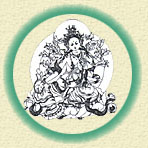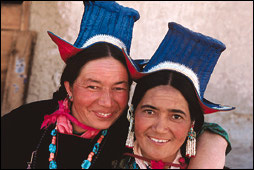Denise M. Simone
Susan E. Wagner High School English Department
A Literary View of Himalayan Women Through Religious and Cultural Texts

For Teachers:
This webpage is designed to offer a unit on The Himalayas accessible to teachers 9-12 in humanities, language arts, social studies and/or art with a focus on women.
Why study The Himalayas?
This unit offers a myriad of opportunities to examine Asian culture in an area of the world in great transition. The Himalayas offer ethnic, religious and cultural diversity. A study of The Silk Road, world religions and Asian arts and literature would not be complete without a glimpse at this region.
Click here for New York State Standards served
Recommended Resources:
Websites:
The University of Virginia Tibetan and Himalayan Digital Library
The Tibetan Buddhist Resource Center

Recommended Films:
Himalaya (Available from Amazon.com)
Compassion in Exile: The Story of the Dali Lama (Available from Amazon.com)
Learning from Ladakh (Available from Videosforlearning.com)
Lesson Strategies:
This webpage offers several genres of Himalayan literature, poetry, autobiographical narrative and religious stories, writings and quotations. Provided for you are hand-outs and brief lesson narratives to support your classroom as well as photographs, artwork and links to useful websites.
I recommend using the literature as a springboard for encouraging student writing. Here are a few useful strategies:
The double-entry journal: A useful tool for supporting reading material. Students complete the journal (see sample journal form) as they read assigned material. This tool is excellent for follow-up discussion and group work. It helps students organize their thoughts as they read. Teachers may modify the form as needed. The left side of the journal records what is read. The right side is reflective of the notes taken on the left.
Found Poetry: This creative writing exercise is an excellent way to reinforce facts, concepts and vocabulary. It is accessible to all; it is easy to explain. Here is a definition:
Found Poetry
From Wikipedia, the free encyclopedia www.enwikipedia.org/wiki/found_poetry.
Found poetry is the rearrangment of words or phrases taken randomly from
other sources (example: clipped newspaper headlines, bits of advertising
copy, handwritten cards pulled from a hat) in a manner that gives the
rearranged words a completely new meaning.
A classic example was found in a physics text:
"And yet no force, however great,
can stretch a cord, however fine,
into a horizontal line
that shall be absolutely straight."
In order to do this, it requires the poet to draw upon not only mental
creativity but his or her own unconscious attitude regarding the nature
of language. Structurally, it is similar to the process of creating a
visual collage composition. Stylistically, it is similar to the visual
art of "appropriation" in which two- and three-dimensional art
is created from recycled items, giving ordinary/commercial things new
meaning when put within a new context in unexpected combinations or juxtapositions.
Appropriation art often plays upon a double-edged meaning, wherein the
object's new artistic meaning makes a political or philosophical comment
on its original purpose, and the same can be said for the way 'found poetry'
can contain clever wordplay or evoke ironic contradictions in the way
we use language.
Students can use any of the reading for the found poetry. All the texts will lend themselves interesting works. I recommend you limit the amount of text each student will glean words from. It iseasierto do found poetry with a paragraph or two rather than a full text. These found poems can be printed, decorated and displayed on a bulliten board with the original texts next to them.
Monologue Writing: Students can write monologues to be performed and or filmed. Have students select a text from the readings and develop a short monologue in the "voice" of the person writing the text. An example would be Tashi Tsering's mother speaking about marriage to two men.
This webpage will provide your students with several guided journal questions, the double-entry journal format and a wealth of literature, pictures and links.
If you have any questions, you can e-mail me at LadyMacbeth@si.rr.com.
Enjoy,
Denise Simone
This site was created by .... at the NEH Summer Institute "Cultures and Religions of the Himalayan Region," held at the College of the Holy Cross, Summer 2004